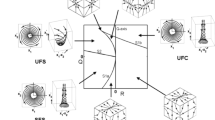Abstract
Observations are presented from calculations where a laminar spherical CH4/air flame was perturbed successively by incident and reflected shock waves reflected from a planar or concave wall. The two-dimensional axi-symmetric Navier–Stokes equations with detailed chemistry were used. The computational results were qualitatively validated with experiments which were performed in a standard shock tube arrangement. Under the influence of the incident shock wave, a Richtmyer–Meshkov instability is induced in the flame, and the distorted flame finally takes the form of two separated elliptical burning bubbles in the symmetric cross plane. Then, under subsequent interactions with the shock wave reflected from the planar or the concave wall, the flame takes a mushroom-like shape. Transverse waves produced by the shock reflection from the concave wall can compress the flame towards the axis, and the focusing shock generated on the concave wall will lead to a larger mushroom-like flame than that induced by the planar reflection.
Similar content being viewed by others
References
Markstein G.H.: Nonsteady Flame Propagations. Mac-Millan, New York (1964)
Thomas G.O., Bambrey R., Brown C.: Experimental observations of flame acceleration and transition to detonation following shock–flame interaction. Combust Theory Model. 5, 573–594 (2001). doi:10.1088/1364-7830/5/4/304
Batley G.A., McIntosh A.C., Brindley J., Falle S.A.E.G.: A numerical study of the vorticity field generated by the baroclinic effect due to the propagation of a planar pressure wave through a cylindrical premixed laminar flame. J. Fluid Mech. 279, 217–237 (1994). doi:10.1017/S0022112094003897
Khokhlov A.M., Oran E.S., Chtchelkanova A.Y., Wheeler J.C.: Interaction of a shock with a sinusoidally perturbed flame. Combust Flame 117, 99–116 (1999). doi:10.1016/S0010-2180(98)00090-X
Ju Y., Shimano A., Inoue O.: Vorticity generation and flame distortion induced by shock–flame interaction. Proc. Combust Inst. 27, 735–741 (1998)
Khokhlov A.M., Oran E.S., Thomas G.O.: Numerical simulation of deflagration-to-detonation transition: the role of shock–flame interactions in turbulent flame. Combust Flame 117, 323–339 (1999). doi:10.1016/S0010-2180(98)00076-5
Gamezo V.N., Khokhlov A.M., Oran E.S.: The influence of shock bifurcations on shock–flame interactions and DDT. Combust Flame 126, 1810–1826 (2001). doi:10.1016/S0010-2180(01)00291-7
Oran, E.S., Gamezo, V.N., Khokhlov, A.M. (2002) Effects of boundary layers and wakes on shock–flame interactions and DDT. AIAA Pap., 0776
Oran, E.S. (2006) Shock driven nonequilibrium turbulence and high-speed deflagration. AIAA Pap., 1524
Oran E.S., Gamezo V.N.: Origins of the deflagration- to-detonation transition in gas-phase combustion. Combust Flame 148, 4–47 (2007). doi:10.1016/j.combustflame.2006.07.010
Gelfand B.E., Khomik S.V., Bartenev A.M., Medvedev S.P., Groing H., Olivier H.: Detonation and deflagration initiation at the focusing of shock waves in combustible gaseous mixture. Shock Waves. 10, 197–204 (2000). doi:10.1007/s001930050007
Bartenev A.M., Khomik S.V., Gelfand B.E., Gronig H., Olivier H.: Effect of reflection type on detonation initiation at shock-wave focusing. Shock Waves 10, 205–215 (2000). doi:10.1007/s001930050008
Leveque R.J.: Finite Volume Methods for Hyperbolic Problems. Cambridge University Press, Cambridge (2002)
Dong G., Fan B.C., Ye J.F.: Numerical investigation of ethylene flame bubble instability induced by shock waves. Shock Waves 17, 409–419 (2008). doi:10.1007/s00193-008-0124-3
Dong G., Fan B.C., Xie B., Ye J.F.: Experimental investigation and validation of explosion suppression by inert particle in large-scale duct. Proc. Combust Inst. 30, 2361–2368 (2005). doi:10.1016/j.proci.2004.07.046
Tamura, Y., Fuji, K. (1990) Visualization for computational fluid dynamics and the comparison with experiments. AIAA Pap., 3031
Author information
Authors and Affiliations
Corresponding author
Additional information
Communicated by S. Dorofeev.
Rights and permissions
About this article
Cite this article
Gui, M., Fan, B., Dong, G. et al. Interaction of a reflected shock from a concave wall with a flame distorted by an incident shock. Shock Waves 18, 487–494 (2009). https://doi.org/10.1007/s00193-008-0177-3
Received:
Revised:
Accepted:
Published:
Issue Date:
DOI: https://doi.org/10.1007/s00193-008-0177-3



